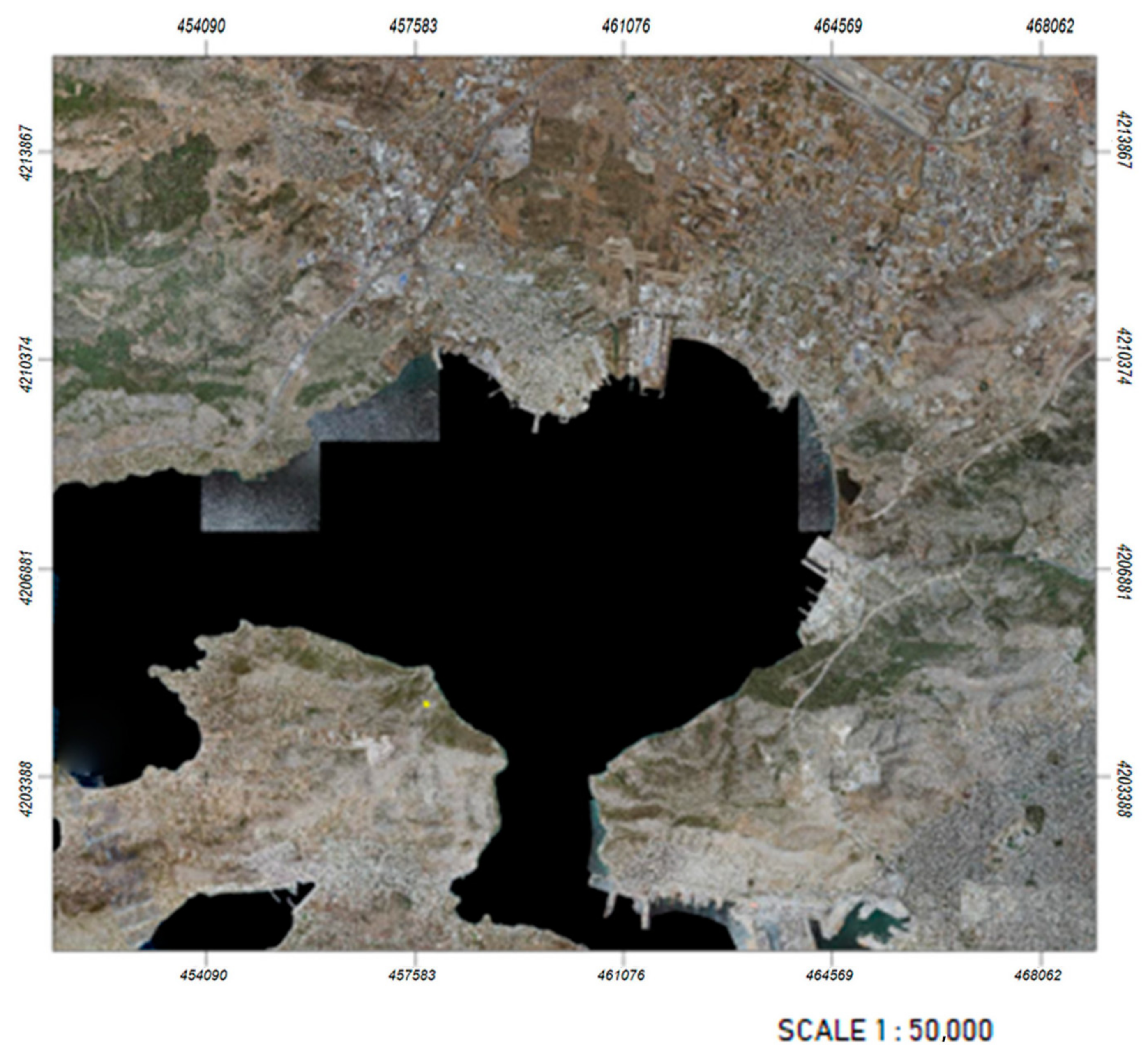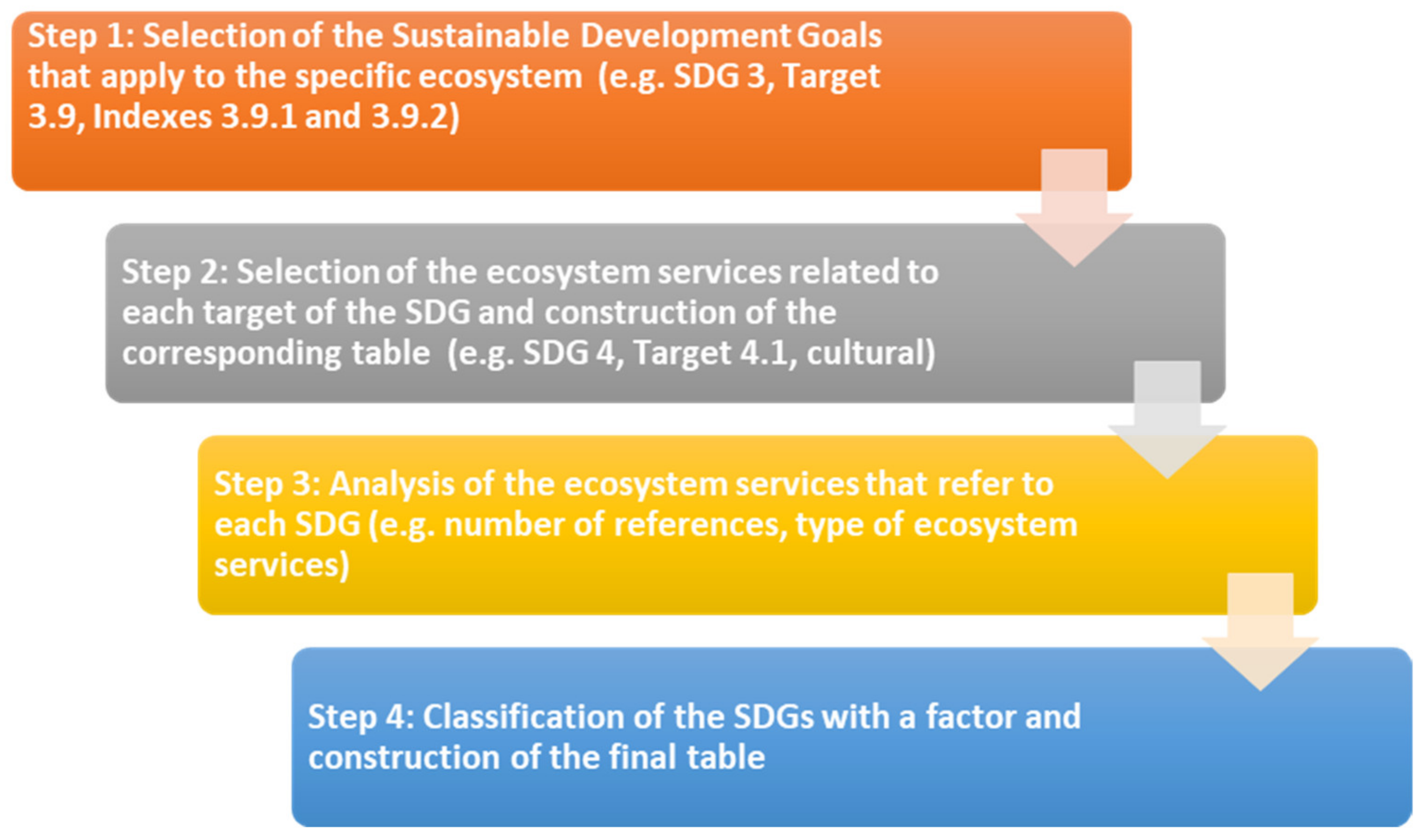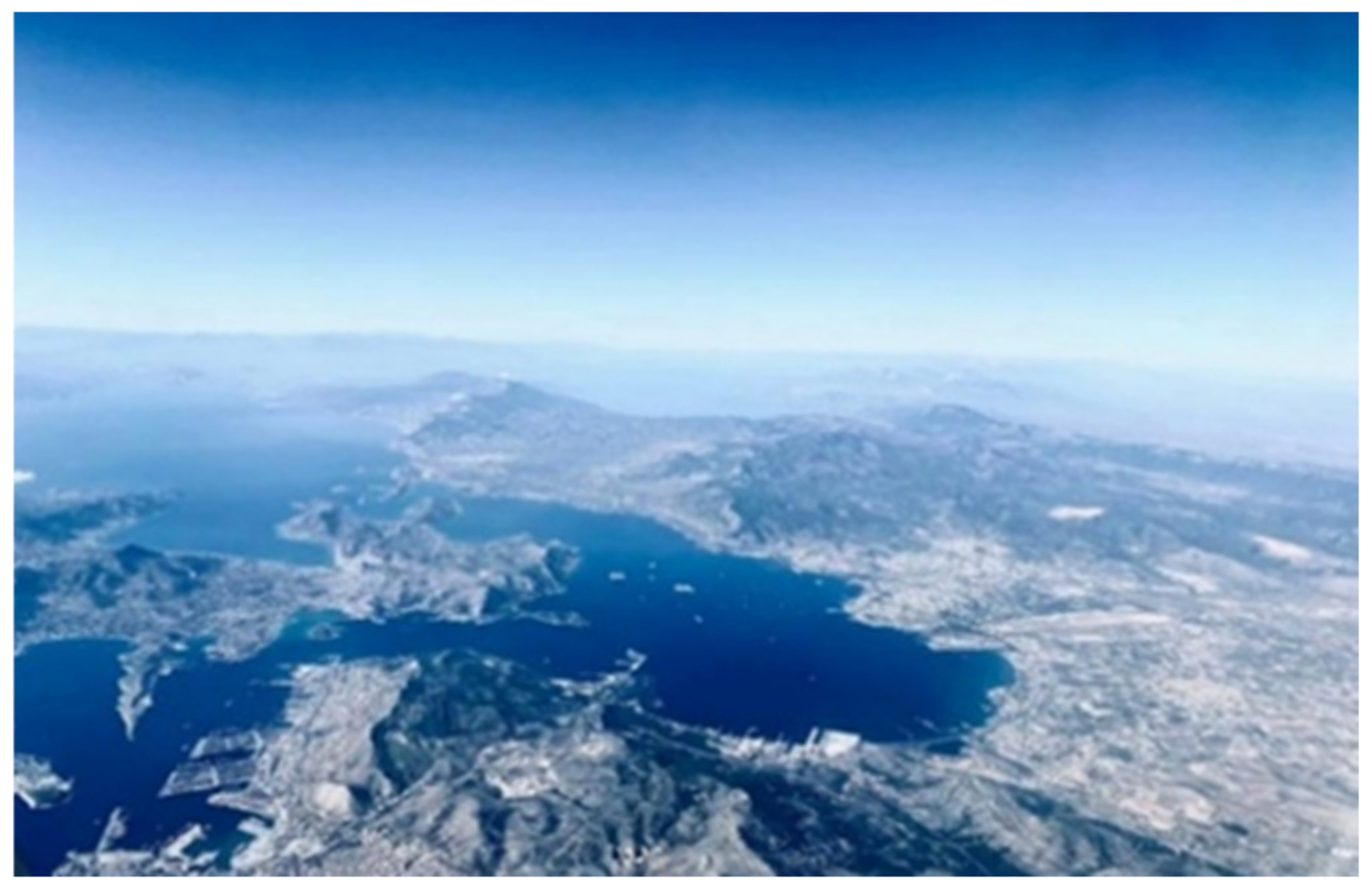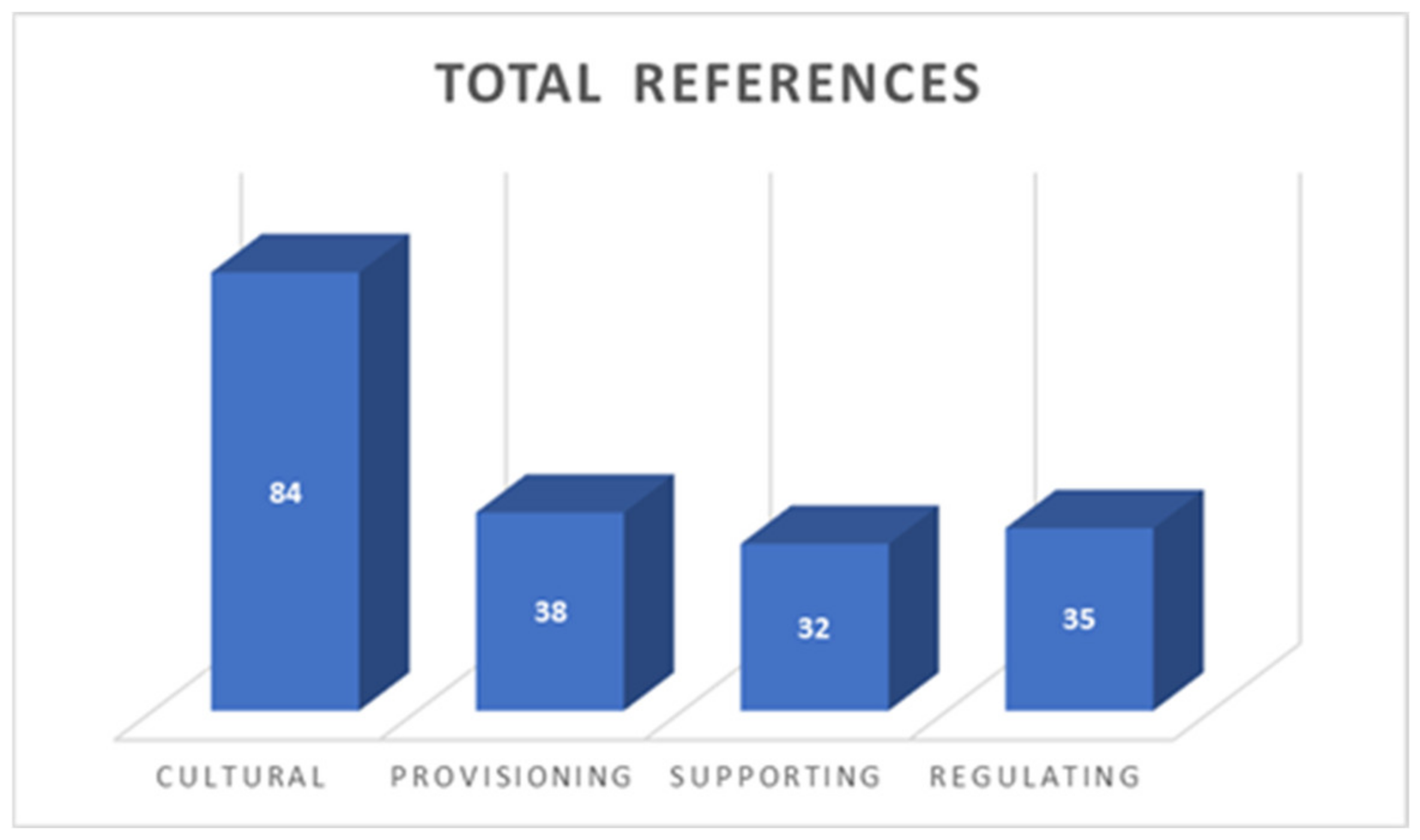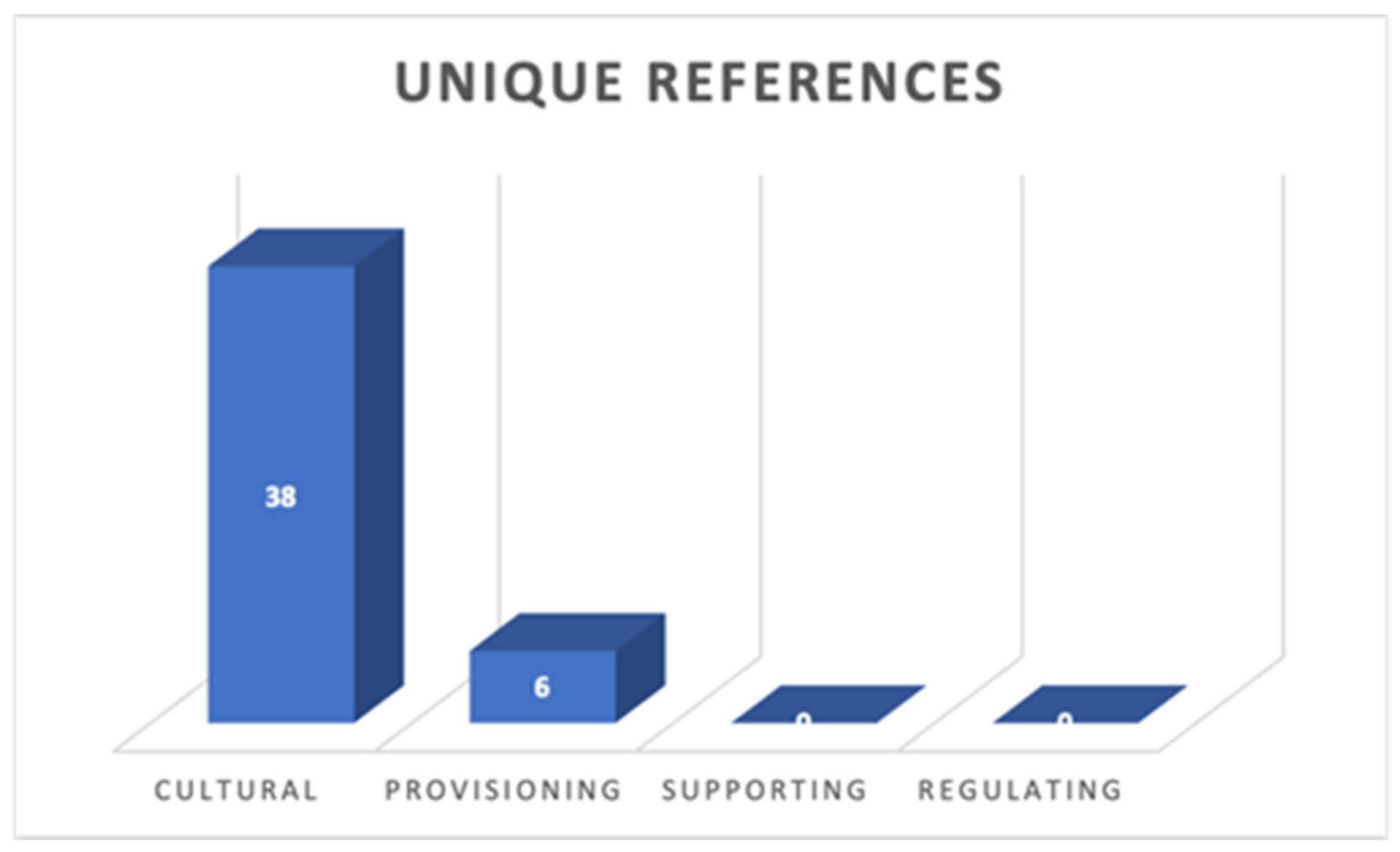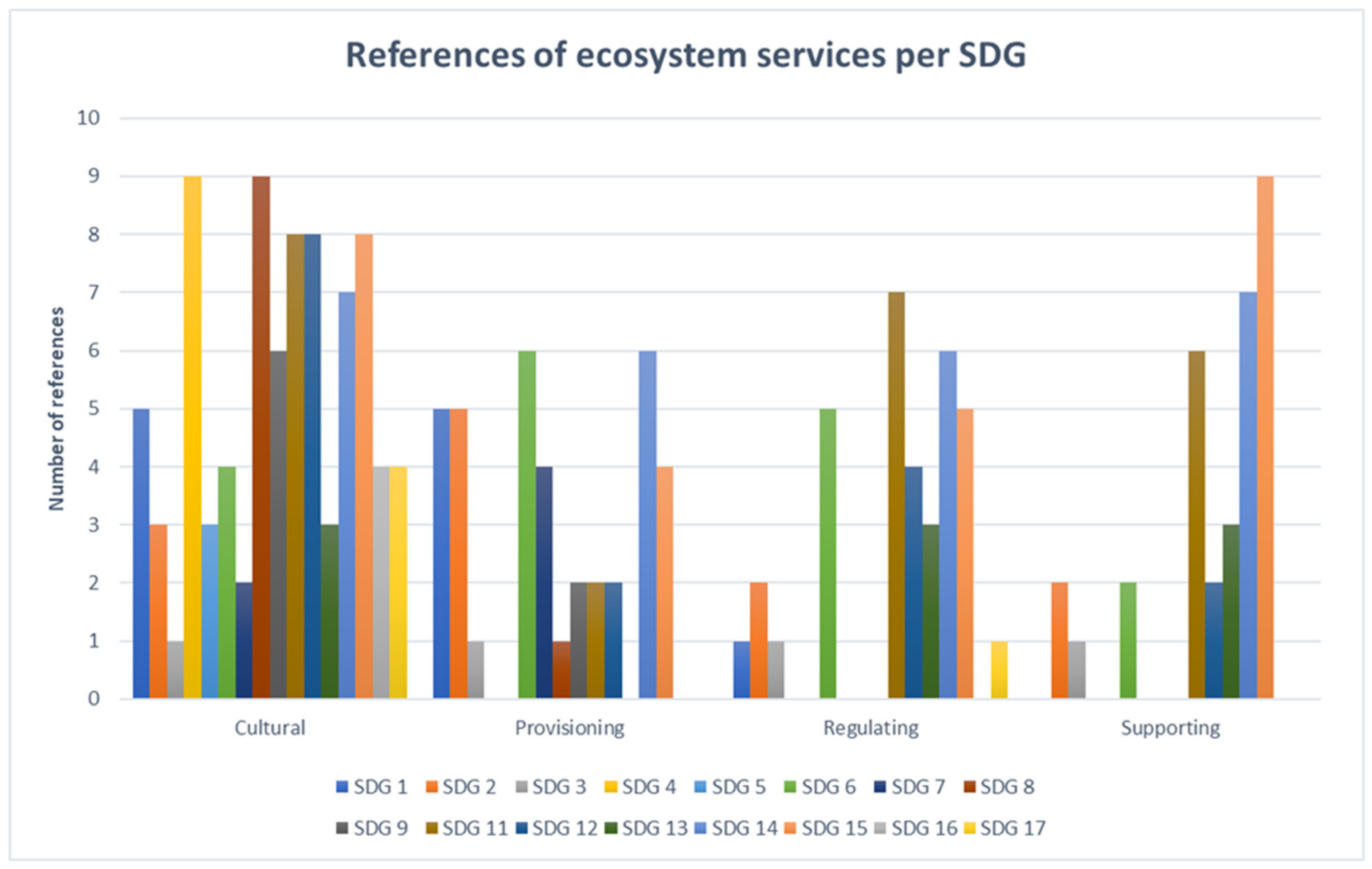1. Introduction
The ocean is the world’s largest ecosystem and faces a wide range of threats, and the achievement of sustainability and the SDGs is the only way to protect it. Additionally, the coastal zone concentrates a large share of industrial activity and, at the same time, remains a tourist destination. Tourism, industry, marine traffic, and port activities increase the pressures on the coastal environment, which remains a vulnerable ecosystem with an intense need for sustainability.
1.1. The Sustainable Development Goals
The concept of the Sustainable Development Goals (SDGs) was first introduced in 2015 by the United Nations, aiming to embrace sustainability and global resilience, increasing the supply of goods and services to the people, and protecting the environment at the same time [
1]. The Sustainable Development Goals are also often referred to as the Global Goals, because of the concept’s worldwide range [
2]. Moreover, the structure of the SDGs consists of 17 different goals that aim to achieve sustainability in 17 important sectors. It should be mentioned that the SDGs are defined in 169 targets, and each target is measured by one or more indexes. The introduction of the SDGs provides a deeper understanding of the need for sustainability and further improvement. Among the SDGs, there are many goals and targets that picture the need for synergies and tradeoffs between different sectors, especially when it comes to sustainable ocean management [
3].
1.2. Ecosystem Services
The ecosystem services are widely expressed as goods and services that people derive from the natural environment and benefit from in various ways [
4,
5]. The concept of ecosystem services connects the function of the ecosystem with human wellbeing and prosperity at regional and global levels [
6]. The continuously growing population, the industrial development, and the reduced availability of natural resources are some of the reasons of the degradation and depletion of the ecosystem services [
4,
7,
8]. Also, ecosystem services reflect the contribution of ecosystems to humans, but the term is more anthropocentric [
9]. These services are defined depending on the specific benefits they provide to individuals or to biosociety as a whole. The benefits that people derive from the ecosystem can be direct or indirect and are classified into provisioning, regulating, supporting, and cultural ecosystem services [
4,
10].
More specifically, provisioning ecosystem services are linked to ecological functions that provide to the people food, water, oxygen, fiber, and more [
4]. Regulating ecosystem services play the role of balancing the currents that are necessary for human existence, such as water, nutrients, and energy [
11]. On the other hand, cultural ecosystem services are defined as the contributions of the ecosystem to the non-material benefits arising from the complex and dynamic relationships between ecosystems and people [
12]. Finally, supporting ecosystem services are considered as the fundamental processes of the ecosystem and, for this reason, they constitute the basic services, which directly support the other three ecosystem services categories [
13]. The most known list of ecosystem services was introduced by the Millennium Ecosystem Assessment in 2005 and included 18 different ecosystem services, classified into four basic categories. Since then, the list of ecosystem services has been updated, according to the preferred classification system, and new services have been added, such as carbon sequestration and pollination. An integrated understanding of the current use of various ecosystem services affects environmental management decisions. The introduction of new elements such as indicators, statistics, or economic values is necessary for the analysis and the management of the present processes and functions of the ecosystem, but also of goods that it produces and are considered benefits for humans [
14].
1.3. Coastal Zone and Land Uses
The coastal zone represents 9% of the land worldwide and it is estimated that around 27% of people all over the world live within the coastal zone. This fact constitutes the coastal zone as a highly populated part of the land, where economic and social growth continuously arise [
15]. An expected consequence of the rapid development and growth of the coastal zone is the creation of significant environmental pressures connected to human activities that affect the coastal ecosystem. Today, it is estimated that about 87% of the marine environment is facing the impacts of those pressures [
16]. At the same time, the operation of new industrial activities in the ocean and in the coastal zone may lead to further deterioration of the already pressured marine ecosystem [
17]. Land use changes along the coastal zone affect the ecological functions of the coastal ecosystem and the related ecosystem services, while land use change is among the main drivers of human activities pressuring the natural environment [
18,
19]. Consequently, land use change plays a significant role in the interaction of the ecosystem with the human–environment interaction [
20]. Additionally, the land use changes are the main reason that ecosystem services differ in each region and period [
21,
22].
In this paper, the selected type of ecosystem is a coastal ecosystem, and its land uses include a protected natural area, significant cultural heritage sites, tourism, industrial activity, port, and urban development.
As for the structure of the present paper,
Section 2 presents the conceptual framework and the steps of the integrated approach for the sustainable blue economy in a vulnerable coastal ecosystem. Following this, the case study of Elefsis Gulf with its specific characteristics is introduced, where the approach is implemented. The fourth chapter indicates the results of the application of the approach in the study area, followed by a discussion on the findings of the results’ analysis and the conclusions of this research.
2. Methodology
2.1. An Integrated Approach for Sustainable Blue Economy
According to the United Nations, it is supposed that the ocean-based economy is worth about 3 trillion dollars per year [
23]. To remain sustainable, the growth obtained from blue economy activities should protect and preserve the natural resources of the ocean ecosystem. The blue economy, as a continuously expanding field of growth with a significant pace of development, provides people with a series of benefits on multiple levels. Consequently, a clean ocean is important and crucial for the achievement of the SDGs, while it is demanded by most stakeholders [
24,
25]. According to the sustainable development principles, economic growth should be obtained with respect to the environment and social cohesion. Within this framework, the use of the ecosystem services concept under the prism of sustainable development can help investigate the provision of services from the coastal ecosystem to the people through an ecosystem approach with the human–environment interaction. In other words, an integrated ecosystem approach offers a spherical investigation of the services that could be obtained from the coastal ecosystem for the benefit of the society, ensuring, in parallel, environmental protection.
2.2. Theoretical Framework
Since the coastal zone interferes with many blue economy activities, ecosystem services are a key tool of environmental management and, simultaneously, since there is an emerging need for the achievement of a sustainable blue economy in the coastal zone, an integrated approach is proposed. Many coastal ecosystems—especially in the Mediterranean—host industrial activities, urban development, and cultural sites. These coastal ecosystems are even more vulnerable, and the adoption of a sustainable blue economy framework is required. Consequently, using as a case study a vulnerable coastal ecosystem, an integrated approach is formed, based on the SDGs and the ecosystem services concepts and exploring the interlinkages of the ecosystem’s parameters from both sides. The SDGs and the ecosystem services are based on the same fundamentals, while both concepts depend on the terms of society–environment–economy, the three pillars of sustainability (
Figure 1). The outcome of this study is the formation of a decision-making tool for sustainable blue economy in a coastal ecosystem with the specific characteristics of a protected natural area, industrial activity, urban development, and great cultural heritage. This is the added value of this research, as no previous research has been conducted combining the tools of the SDGs and the ecosystem services, while there is a lack of methodologies in this field [
26,
27,
28].
This decision-making tool will give important information for the coastal ecosystem. Firstly, this tool will provide an analysis and classification of the ecosystem services according to their importance for the achievement of sustainability. Secondly, it will classify the SDGs with a corresponding factor, according to their importance for the sustainable blue economy of a coastal ecosystem. In this way, information will be provided to stakeholders on which SDGs they should focus and will help them prioritize their actions toward the achievement of sustainability in the specific ecosystem. This approach consists of four major steps, as shown in
Figure 2 below.
In the first step, the SDGs and their targets that are related to the coastal ecosystem are selected. In the second step, the ecosystem services that are related to each target of the SDG are chosen, and the corresponding table is constructed. In the third step, the analysis of the table takes place, focusing on the references of the ecosystem services per SDG. The final step includes the classification of the SDGs with a corresponding factor, based on the results of the previous step. The outcome of this step is the creation of a table presenting each SDG and the corresponding factor of importance for the sustainable blue economy in the specific coastal ecosystem.
Following the above steps, this approach indicates the SDGs in which focus should be given, as the dimensions and the parameters of sustainability are numerous, as well as the SDGs. In this way, stakeholders will be one step closer to the achievement of a sustainable blue economy, while this tool can be used for the design of compensatory measures of industries, as well as the long-term strategies of companies and organizations and other studies of related stakeholders. The list of the SDGs and their targets that are used in Step 1 are part of the official list of the United Nations [
1]. Accordingly, the list of ecosystem services that are used in Step 2 is presented in
Table 1 and includes 30 ecosystem services, based on the TEEB classification [
4,
29,
30].
In this study, the cultural ecosystem services are captured as socioeconomic ecosystem services, under an anthropocentric approach, including the direct and indirect services provided by the ecosystem. Under this conceptualization, the cultural ecosystem services express the socioeconomic part of sustainability and include the human development through the ecosystem, covering a wide range of social skills and services that are related to the human–environment interactions [
31].
3. The Study Area
The case study of this paper is Elefsis Gulf (
Figure 3 and
Figure 4), a coastal ecosystem in Central Greece with the special characteristics of cultural heritage and interest, industrial activity, port, urbanization, and protected natural area [
32]. The gulf of Elefsis presents increased scientific interest and is supposed to be one of the most studied coastal areas in the eastern Mediterranean, because of its unique characteristics, its location—just 18 km of the historic capital of Athens—and its important cultural past—the ancient city of Elefsis was one of the four sacred cities of the ancient world [
33].
The maximum depth in the gulf of Elefsis is 35 m, while the western part of the bed is the deepest operating as a sediment trap and the eastern part of the bed has a smaller depth that fluctuates from 10 to 25 m [
34,
35]. The acreage of Elefsis Gulf is 68 km
2, shaping a small and semi-closed bay [
36]. The gulf of Elefsis is connected to the Saronic Gulf through two narrow and shallow inlets [
37]. As for the temperature data in the gulf of Elefsis, the maximum temperature appears in the months of July and August, reaching 25 °C, while the lowest temperatures are reported in the months February and March, reaching 10 °C [
37]. The study area includes the protected natural area of lake Koumoundourou, an ecosystem with high environmental and cultural importance. More specifically, Lake Koumoundourou includes numerous species of avifauna (gulls, starlings, and more) and flora, while, since the 1970s, it has been protected by law as an archeological site [
38]. The main urban settlement in the study area is the homonym city of Elefsis, which is also the European Capital of Culture for 2023 [
39].
Figure 4.
The Gulf of Elefsis (Greece) [
40].
Figure 4.
The Gulf of Elefsis (Greece) [
40].
Pressures
The gulf of Elefsis receives various environmental pressures throughout the years, connected to multiple polluting sources. The industrial and maritime activities carried out in the coastal zone of Elefsis Gulf play an important role in the pressures acted in it and gradually degrade its environmental status [
37,
41]. These industrial and maritime activities are associated with the occurrence of eutrophication phenomena, high rates of hydrocarbons, and heavy metals [
41,
42]. Moreover, the gulf of Elefsis is a passage for many vessels such as tankers, cargo ships, and cruise ships vessels [
43]. At the same time, two ports and large industrial plants such as oil refineries, cement and steel industries, and shipyards operate on the coastal zone of the bay. Other pressures connected to human activities are the urbanization and seasonal tourism in the coastal zone of Elefsis.
4. Results
The application of the integrated approach on the coastal ecosystem of Elefsis Gulf starts with the selection of the SDGs and their accompanying targets and indexes, that apply to the specific ecosystem. Each SDG is expressed by targets, while each target is measured by one or more indexes. Following that, the ecosystem services of Elefsis Gulf related to each target of the SDG are chosen, as shown in
Table S1 (Supplementary Material).
As it can be concluded from
Table S1, the interlinkages between some SDGs and the ecosystem services are multilevel and depict the special characteristics of the coastal ecosystem. From the analysis of
Table S1, regarding the references of the types of ecosystem services, useful and interesting conclusions can be drawn. Firstly, the total references per type of ecosystem service are analyzed and are presented in
Figure 5 below. It should be noted that a large difference appears between the number of references of the cultural ecosystem services and the other types of ecosystem services. More specifically, the cultural ecosystem services are mentioned 84 times, while the provisioning ecosystem services 38 times, the regulating ecosystem services 35 times, and the supporting ecosystem services 32 times.
Following this, the unique references of the ecosystem services (when only one type of ecosystem service corresponds to a target) are analyzed. As presented in
Figure 6, the unique references of the cultural ecosystem services are 38, while the provisioning ecosystem services have 6 unique references and the supporting and regulating ecosystem services have zero unique references. It should be noted that also in this case, the difference between the references is large, as the cultural ecosystem services have significantly more references than the other types of ecosystem services.
Moving onto a more complex analysis, the references of the type of ecosystem services per SDG are investigated and are presented in
Figure 7 below. The cultural ecosystem services are related to 16 SDGs (practically all the SDGs included in
Table S1), while the regulating ecosystem services are related to 10 SDGs, the provisioning ecosystem services to 8 SDGs, and the supporting ecosystem services are related to 8 SDGs too. It should be noted that SDG 4 (Quality education), SDG 5 (Gender equality), and SDG 16 (Peace, justice, and strong institutions) are connected exclusively to cultural ecosystem services. Also in this case, the cultural ecosystem services dominate the SDG analysis, with a noteworthy difference from the other types of ecosystem services.
As presented in
Table 2, some SDGs have significantly more references than the others, which means that they correspond to more ecosystem services than other SDGs. More precisely, SDGs 14 (Life below water) and 15 (Life on land) have the most references between the other SDGs—26 each, while SDG 11 (Sustainable cities and communities) has 23 references. Following this, SDG 6 (Clean water and sanitation) has 17 references, SDG 12 (Responsible consumption and production) follows with 16 references, SDG 2 (Zero hunger) with 12 references, SDG 1 (No poverty) with 11 references, SDG 8 (Decent work and economic growth) has 10 references, SDGs 4 (Quality education) and 13 (Climate action) have 9 references each, SDG 9 (Industry, innovation and infrastructure) has 8 references, SDG 7 (Affordable and clean energy) has 6 references, SDG 17 (Partnerships for the goals) has 5 references, SDGs 3 (Good health and wellbeing) and 16 (Peace, justice and strong institutions) have 4 references each, and finally SDG 5 (Gender equality) has 3 references.
Classification of the SDGs
From the above results, we conclude that some SDGs and targets have increased importance for the sustainable blue economy in a coastal ecosystem, while others are less critical for the achievement of sustainability in the specific ecosystem. The same applies for the ecosystem services, where some types of ecosystem services affect more SDGs than others and play a stronger role for the attainment of a sustainable blue economy in the coastal ecosystem. Accordingly, the evaluation of the above SDGs and their classification are conducted regarding their importance for the sustainable blue economy of the coastal ecosystem. The classification of the SDGs for sustainable blue economy in a coastal ecosystem is proposed in
Table 3 below. The factor of each SDG is based on the percentage of the total references of ecosystem services and expresses the importance of the SDGs for the sustainable blue economy of the coastal ecosystem.
As presented in
Table 3, SDGs 14, 15, 11, 6, and 12 gather the majority of the references of ecosystem services with a percentage of 57.13% and are considered to have increased importance for the attainment of sustainability in the coastal ecosystem. Consequently, more focus should be given to activities connected to SDGs 14, 15, 11, 6, and 12 over the other SDGs in order to achieve sustainable blue economy in the coastal ecosystem.
5. Discussion
Cultural ecosystem services cover the majority of the SDGs, as 44.4% of the SDGs’ targets are connected to cultural ecosystem services, while some SDGs are exclusively connected to cultural ecosystem services. Moreover, the unique references of the cultural ecosystem services dominate over the other ecosystem services with a remarkable difference. It is obvious that the cultural ecosystem services are an integral part of the SDGs and sustainable development. This can be explained by the fact that the cultural ecosystem services express two of the three pillars of sustainability, the social and the economic one. It is also attributed to the fact that the social aspect is combined with most of the human activities, even the basic ones, such as housing, food, and water, as the need for survival is not only practical but spiritual too. The list of cultural ecosystem services includes a wide range of services that strengthen the social and economic aspect of the ecosystem, such as education, tourism, and recreation.
Additionally, some SDGs cover more ecosystem services than others, which indicates an increased influence of these SDGs on the sustainable blue economy of the coastal ecosystem of Elefsis Gulf. As the fourth step of the integrated approach, the classification of the SDGs showed that five SDGs (Life below water, Life on land, Sustainable Cities and Communities, Clean water and sanitation, Responsible consumption and production) affect more the coastal ecosystem of Elefsis Gulf and its ecosystem services, and more focus should be given to their achievement.
6. Conclusions
The coastal zone is an impaired ecosystem, hosting a wide range of economic and social activities, and a natural ecosystem, important for the preservation of biodiversity and environmental balance. To investigate the priorities and the necessary actions toward a sustainable blue economy on the coastal zone, an integrated approach is required. Since the ecosystem services and the SDGs are based on the same fundamentals, a decision-making tool is formed, analyzing the interlinkages of the SDGs and the ecosystem services of a vulnerable coastal ecosystem. The SDGs-ecosystem services approach provides a systematic view of the sustainable blue economy status and priorities of the coastal ecosystem and can further be used as a management and decision-making tool from all stakeholders. The application of this approach to the Gulf of Elefsis indicates that the cultural ecosystem services play an important role in a coastal ecosystem with cultural heritage, natural environment, urban development, and industry, while focus should be given to the achievement of SDGs 14, 15, 11, 6, and 12. The accomplishment (or even the work toward the accomplishment) of the SDGs can improve the services and the goods that the ecosystem provides to the people.
Consequently, the integrated approach reflects the necessity of specific SDGs and ecosystem services and the special clout that should be given to them. In this direction, a decision-making tool for stakeholders has been developed, proposing the prioritization of the SDGs that should be achieved for a sustainable blue economy in a coastal ecosystem. Finally, this analysis could also be considered as a step to a qualitative approach of the ecosystem services through the SDGs.
Author Contributions
Conceptualization, A.P.; methodology, A.P., F.S. and D.K.; formal analysis, A.P., F.S. and D.K.; investigation, A.P.; resources, A.P., F.S. and D.K.; writing—original draft preparation, A.P.; writing—review and editing, F.S. and D.K., visualization, A.P.; supervision, F.S.; project administration, A.P., F.S. and D.K. All authors have read and agreed to the published version of the manuscript.
Funding
This research received no external funding.
Institutional Review Board Statement
Not applicable.
Informed Consent Statement
Not applicable.
Data Availability Statement
Not applicable.
Conflicts of Interest
The authors declare no conflict of interest.
References
- United Nations (UN). Transforming Our World: The 2030 Agenda for Sustainable Development. 2015. Available online: https://sustainabledevelopment.un.org/post2015/transformingourworld (accessed on 29 November 2022).
- United Nations Development Program (UNDP). Available online: https://www.undp.org/sustainable-development-goals (accessed on 10 December 2022).
- Griggs, D.; Smith, M.S.; Rockström, J.; Öhman, M.C.; Gaffney, O.; Glaser, G.; Kanie, N.; Noble, I.; Steffen, W.; Shyamsundar, P. An integrated framework for sustainable development goals. Ecol. Soc. 2014, 19, 24. [Google Scholar] [CrossRef]
- Millennium Ecosystem Assessment. Ecosystems and Human Wellbeing: Synthesis; Island Press: Washington, DC, USA, 2005. [Google Scholar]
- Schroter, M.; Bonn, A.; Klotz, S.; Seppelt, R.; Baessler, C. Atlas of Ecosystem Services; Springer Nature: Berlin/Heidelberg, Germany, 2019. [Google Scholar]
- Darvill, R.; Lindo, Z. The inclusion of stakeholders and cultural ecosystem services in land management trade-off decisions using an ecosystem services approach. Landsc. Ecol. 2016, 31, 533–545. [Google Scholar] [CrossRef]
- Cimon-Morin, J.; Darveau, M.; Poulin, M. Fostering synergies between ecosystem services and biodiversity in conservation planning. A review. Biol. Conserv. 2013, 166, 144–154. [Google Scholar] [CrossRef]
- Rands, M.R.; Adams, W.M.; Bennun, L.; Butchart, S.H.M.; Clements, A.; Coomes, D.; Entwistle, A.; Hodge, I.; Kapos, V.; Scharlemann, J.P.W.; et al. Biodiversity conservation: Challenges beyond 2010. Science 2010, 329, 1298–1303. [Google Scholar] [CrossRef]
- Brockerhoff, E.; Barbaro, L.; Castagneyrol, B.; Forrester, D.; Gardiner, B.; Gonzalez-Olabarria, J.; Lyver, P.; Meurisse, N.; Oxbrough, A.; Taki, H.; et al. Forest biodiversity, ecosystem functioning and the provision of ecosystem services. Biodivers. Conserv. 2017, 26, 3005–3035. [Google Scholar] [CrossRef]
- Díaz, S.; Demissew, S.; Carabias, J.; Joly, C.; Lonsdale, M.; Ash, N.; Larigauderie, A.; Adhikari, J.R.; Arico, S.; Báldi, A.; et al. The IPBES conceptual framework—Connecting nature and people. Curr. Opin. Environ. Sustain. 2015, 14, 1–16. [Google Scholar] [CrossRef]
- Xavier, F.; Prado, R.; Fidalgo, E. Dynamic and maintenance of water purification ecosystem service in the Guandu River Hydrographic Region, Rio de Janeiro, Brazil. RBRH 2023, 28, e12. [Google Scholar] [CrossRef]
- Fagerholm, N.; Käyhkö, N.; Ndumbaro, F.; Khamis, M. Community stakeholders’ knowledge in landscape assessments—Mapping indicators for landscape services. Ecol. Indic. 2012, 18, 421–433. [Google Scholar] [CrossRef]
- Sun, G.; Hallema, D.; Asbjornsen, H. Ecohydrological processes and ecosystem services in the Anthropocene: A review. Ecol. Process. 2017, 6, 35. [Google Scholar] [CrossRef]
- Barnaud, C.; Antona, M. Deconstructing ecosystem services: Uncertainties and controversies around a socially constructed concept. Geoforum 2014, 56, 113–123. [Google Scholar] [CrossRef]
- Fang, X.; Zou, J.; Wu, Y.; Zhang, Y.; Zhao, Y.; Zhang, H. Evaluation of the sustainable development of an island “Blue Economy”: A case study of Hainan, China. Sustain. Cities Soc. 2021, 66, 102662. [Google Scholar] [CrossRef]
- Watson, R.; Tidd, A. Mapping nearly a century and a half of global marine fishing: 1869–2015. Mar. Policy 2018, 93, 171–177. [Google Scholar] [CrossRef]
- Bennett, N.J.; Cisneros-Montemayor, A.M.; Blythe, J.; Silver, J.; Singh, G.; Andrews, N.; Calo, A.; Christie, P.; Franco, A.; Finkbeiner, E.; et al. Towards a sustainable and equitable blue economy. Nat. Sustain. 2019, 2, 991–993. [Google Scholar] [CrossRef]
- Díaz, S.; Pascual, U.; Stenseke, M.; Martín-López, B.; Watson, R.T.; Molnár, Z.; Hill, R.; Chan, K.M.A.; Baste, I.A.; Brauman, K.A.; et al. Assessing nature’s contributions to people. Science 2018, 359, 270–272. [Google Scholar] [CrossRef]
- Mendoza, M.E.; Granados, E.; Geneletti, D.; Pérez-Salicrup, D.; Salinas, V. Analyzing land cover and land use change processes at watershed level: A multitemporal study in the Lake Cuitzeo Watershed, Mexico (1975–2003). Appl. Geogr. 2011, 31, 237–250. [Google Scholar] [CrossRef]
- Hasan, S.S.; Zhen, L.; Ahamed, T.; Samie, A.; Miah, M. Impact of land use change on ecosystem services: A review. Environ. Dev. 2020, 34, 100527. [Google Scholar] [CrossRef]
- Costanza, R.; De Groot, R.; Braat, L.; Kubiszewski, I.; Fioramonti, L.; Sutton, P.; Farber, S.; Grasso, M. Twenty years of ecosystemservices: How far have we come and how far do we still need to go? Ecosyst. Serv. 2017, 28, 1–16. [Google Scholar] [CrossRef]
- Groot, R.; Brander, L.; Van Der Ploeg, S.; Costanza, R.; Bernard, F.; Braat, L.; Christie, M.; Crossman, N.; Ghermandi, A.; Hein, L.; et al. Global estimates of the value of ecosystems and their services in monetary units. Ecosyst. Serv. 2012, 1, 50–61. [Google Scholar] [CrossRef]
- United Nations Environment Programme (UNEP). United Nations. Governing Coastal Resources: Implications for a Sustainable Blue Economy. Available online: https://www.unep.org/resources/publication/governing-coastal-resources-implications-sustainable-blue-economy (accessed on 1 December 2022).
- Nash, K.; Blythe, J.L.; Cvitanovic, C.; Fulton, E.A.; Halpern, B.S.; Milner-Gulland, E.; Addison, P.F.; Pecl, G.T.; Watson, R.A.; Blanchard, J.L. To Achieve a Sustainable Blue Future, Progress Assessments Must Include Interdependencies between the Sustainable Development Goals. One Earth 2020, 2, 161–173. [Google Scholar] [CrossRef]
- Hoegh-Guldberg, O. Reviving the Ocean Economy: The Case for Action; WWF International: Geneva, Switzerland, 2015; Available online: https://www.worldwildlife.org/publications/reviving-the-oceans-economy-the-case-for-action-2015 (accessed on 1 October 2022).
- Zhou, X.; Moinuddin, M.; Renaud, F.; Barrett, B.; Xu, J.; Liang, Q.; Zhao, J.; Xia, X.; Bosher, L.; Huang, S.; et al. Development of an SDG interlinkages analysis model at the river basin scale: A case study in the Luanhe River Basin, China. Sustain. Sci. 2022, 17, 1405–1433. [Google Scholar] [CrossRef]
- Estoque, R.C. A Review of the Sustainability Concept and the State of SDG Monitoring Using Remote Sensing. Remote Sens. 2020, 12, 1770. [Google Scholar] [CrossRef]
- Maurice, J. Measuring progress towards the SDGs—A new vital science. Lancet 2016, 388, 1455–1458. [Google Scholar] [CrossRef] [PubMed]
- Food and Agriculture Organization of the United Nations (FAO). Available online: www.fao.org (accessed on 10 November 2022).
- Ivanić, K.; Stolton, S.; Figueroa, A.; Dudley, N. Protected Areas Benefits Assessment Tool + (PA-BAT+): A Tool to Assess Local Stakeholder Perceptions of the Flow of Benefits from Protected Areas; IUCN: Gland, Switzerland, 2020; pp. xii + 84. Available online: https://portals.iucn.org/library/sites/library/files/documents/PATRS-004-En.pdf (accessed on 10 January 2023).
- Daniel, T. Contributions of cultural services to the ecosystem services agenda. Proc. Natl. Acad. Sci. USA 2012, 109, 8812–8819. [Google Scholar] [CrossRef] [PubMed]
- Pournara, A.; Sakellariadou, F. Development of a Protocol for a Sustainable Blue Economy in the Coastal Zone: Case Study and Preliminary Results in a Coastal Industrial Area in the Eastern Mediterranean. Sustainability 2022, 14, 10323. [Google Scholar] [CrossRef]
- Makri, P.; Hermides, D.; Kontakiotis, G.; Zarkogiannis, S.; Besiou, E.; Janjuhah, H.; Antonarakou, A. Integrated Ecological Assessment of Heavily Polluted Sedimentary Basin within the Broader Industrialized Area of Thriassion Plain (Western Attica, Greece). Water 2022, 14, 382. [Google Scholar] [CrossRef]
- Pavlidou, A.; Kontoyiannis, H.; Anagnostou, C.; Siokou–Frangou, I.; Pagou, K.; Krasakopoulou, E.; Assimakopoulou, G.; Zervoudaki, S.; Zeri, C.; Chatzianestis, J.; et al. Biogeochemical Characteristics in the Elefsis Bay (Aegean Sea, Eastern Mediterranean) in Relation to Anoxia and Climate Changes. In Chemical Structure of Pelagic Redox Interfaces: Observation and Modeling; Yakushev, E.V., Ed.; The Handbook of Environmental, Chemistry; Springer: Berlin/Heidelberg, Germany, 2010; Volume 22, pp. 161–202. [Google Scholar]
- Kanellopoulou, G.; Perdikatsis, B.; Foskolos, A. Geochemical and mineralogical analysis of sediments from the gulf of Elefsina—Study of the anthropogenic impact. Bull. Geol. Soc. Greece 2018, 36, 164–173. [Google Scholar] [CrossRef]
- Evangeliou, N.; Florou, H. The dispersion of 137Cs in a shallow Mediterranean embayment (Saronikos Gulf–Elefsis Bay), estimated inventories and residence times. J. Environ. Radioact. 2012, 113, 87–97. [Google Scholar] [CrossRef]
- Dimiza, M.; Triantaphyllou, M.; Malinverno, E. New evidence for the ecology of Helicosphaera carteri in polluted coastal environments (Elefsis Bay, Saronikos Gulf, Greece). J. Nannoplankton Res. 2014, 34, 37–43. [Google Scholar] [CrossRef]
- Hellenic Center for Marine Research. Assessment of Chemical Parameters (HRC); Hellenic Center for Marine Research: Anavyssos, Greece, 2011. [Google Scholar]
- European Commisision (EC). Culture and Creativity. Three New Capitals of Culture for 2023. Available online: https://culture.ec.europa.eu/ga/news/three-new-capitals-of-culture-for-2023 (accessed on 15 January 2023).
- Ktimatologio. Available online: www.ktimatologio.gr (accessed on 1 July 2023).
- Pavlidou, A. Nutrient Distribution in Selected Coastal Areas of Aegean Sea (East Mediterranean Sea). J. Environ. Sci. Eng. 2012, A1, 78–88. [Google Scholar]
- Prifti, E.; Kaberi, H.; Paraskevopoulou, V.; Michalopoulos, P.; Zeri, C.; Iliakis, S.; Dassenakis, M.; Scoullos, M. Vertical Distribution and Chemical Fractionation of Heavy Metals in Dated Sediment Cores from the Saronikos Gulf, Greece. J. Mar. Sci. Eng. 2022, 10, 376. [Google Scholar] [CrossRef]
- Hahladakis, J.Ν.; Vasilaki, G.; Smaragdaki, E. Application of ecological risk indicators for the assessment of Greek surficial sediments contaminated by toxic metals. Environ. Monit. Assess. 2016, 188, 271. [Google Scholar] [CrossRef] [PubMed]
| Disclaimer/Publisher’s Note: The statements, opinions and data contained in all publications are solely those of the individual author(s) and contributor(s) and not of MDPI and/or the editor(s). MDPI and/or the editor(s) disclaim responsibility for any injury to people or property resulting from any ideas, methods, instructions or products referred to in the content. |
© 2023 by the authors. Licensee MDPI, Basel, Switzerland. This article is an open access article distributed under the terms and conditions of the Creative Commons Attribution (CC BY) license (https://creativecommons.org/licenses/by/4.0/).
